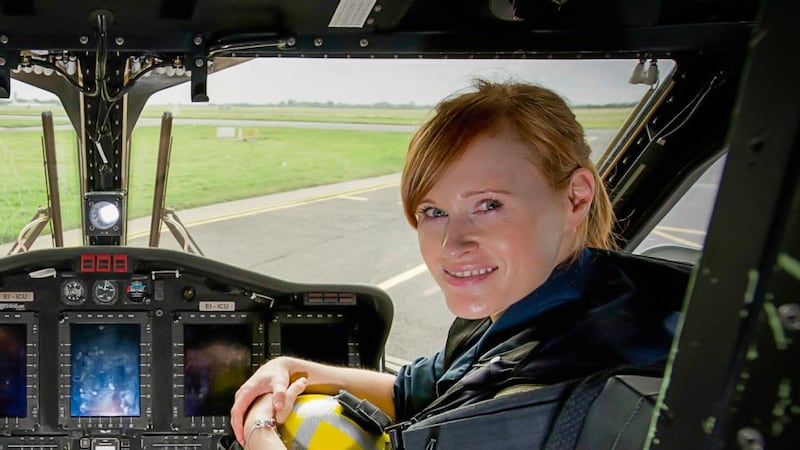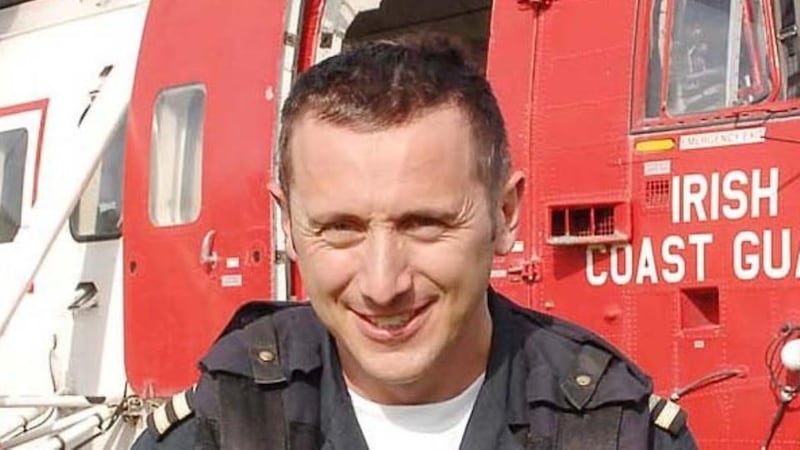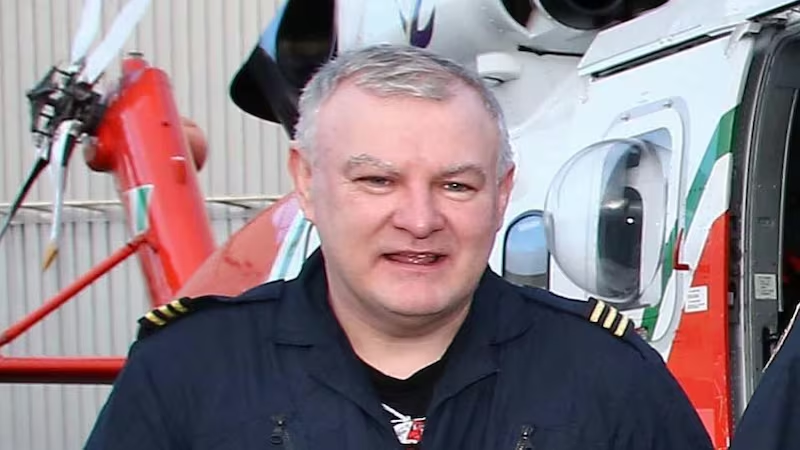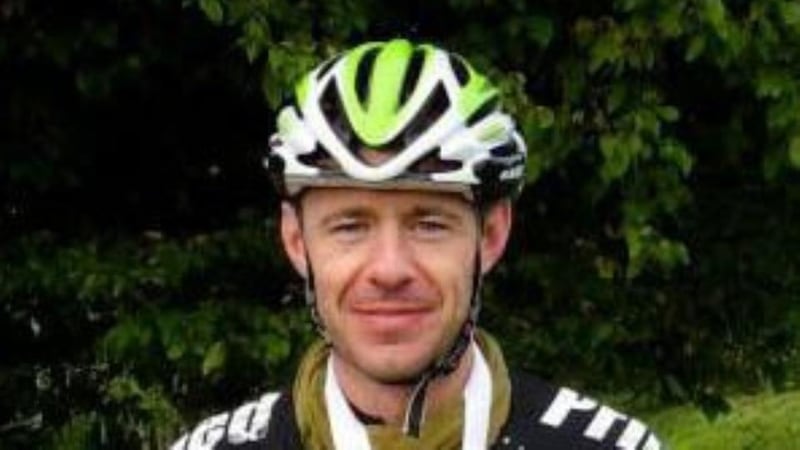Lightkeeper Vincent Sweeney has made many cups of tea for visitors on dark and stormy nights with westerly winds sweeping through the natural amphitheatre of rock and sea created by Achill island, the Atlantic and the Mullet peninsula in north Mayo.
Sweeney is attendant keeper at Blacksod lighthouse, built of granite in 1865 to create a safe anchorage in Broadhaven Bay with Black Rock – an inhospitable island 13 km to the west with precipitous cliffs where three generations of lightkeepers survived before eventual automation.
Since 1981, when he took over his from his father Ted – who issued the famous weather forecast that influenced the 1944 D-day landings – Sweeney has been a familiar welcoming face and voice over VHF for British, Irish and international helicopter crews.
The approach to Blacksod involves sliding 'like a slalom skier between the islands, climbing slightly in case you had drifted and were close to one or another'
The helicopters would land to refuel at Blacksod, having been tasked on missions ranging from servicing lights at Eagle island and Blackrock to conducting or supporting air-sea rescue out west in the Atlantic.
The approach, often at night in the case of an emergency, requires much skill and technique. Former search and rescue pilot David Courtney described it in his book Nine Lives as sliding "like a slalom skier between the islands, climbing slightly in case you had drifted and were close to one island or another, knowing that the black shape to the south was Achill, its northern cliffs at Croaghan standing at 2,192ft, the highest sea cliffs in Europe".
"Vincent would be listening in for us," Courtney wrote. "Always. Always." And so late on the night of March 13th last year and into the early hours of March 14th, Sweeney was at the lighthouse, listening in for the arrival of two Irish Coast Guard helicopters – one, Rescue 118 from Sligo, tasked to undertake a medical evacuation of an injured fisherman 250km west of Eagle Island, and the second, Rescue 116 from Dublin, tasked to provide "top cover" or communications relay for the Sligo crew after the Air Corps confirmed it was not available.
Possible refuelling
Rescue 116 had initially considered Sligo as a possible refuelling route west, after pilot Capt Dara Fitzpatrick, co-pilot Capt Mark Duffy and winch crew Paul Ormsby and Ciarán Smith, took off at 23.03 from Dublin Airport. At this stage, the Sligo-based Rescue 118 had flown west and refuelled at Blacksod lighthouse. There was a brief communication between the two helicopters at that point.
The last radar return recorded by Shannon air traffic control for Rescue 116 was at 00.46 hours. The first indication the helicopter was missing was at 1.06 hours when the helicopter didn’t respond to its call sign from Blacksod. Vincent continued on radio in the lighthouse. His son Simon drove up to a nearby hill and tried reaching the helicopter on a hand-held VHF. Simon’s cousin, Fergus, a film-maker, was close by at home when he heard Simon telling his something had happened and Rescue 116 had “gone down”.
At 1.08, Blackrock lighthouse advised Malin Coast Guard it had no contact with the helicopter. The "Mayday" on marine radio channel 16 was broadcast at 01.13 hours by Malin, and the RNLI Achill and Ballyglass lifeboats were both tasked. At 2.13, the Sligo-based Rescue 118 advised it was back on scene from the medical evacuation and had begun a search.
Three minutes later, at 2.16, the Sligo crew advised that a casualty and debris had been sighted in the water south-east of Blackrock. The strobe lights from an immersion suit were visible on the water.
Capt Dara Fitzpatrick was recovered from the sea by the crew of the Achill lifeboat, which began cardio pulmonary rescuscitation (CPR), but to no avail. Both the Achill lifeboat and the Sligo helicopter continued to circle the area, searching for the other three crew, as further rescue units were scrambled.


42-day search
Over the next 42 days of intensive searching, and beyond, there was an outpouring of public sympathy for the families and friends of the crew. President Michael D Higgins and then taoiseach Enda Kenny led many tributes.
Dara Fitzpatrick (45), the highly experienced airwoman and mother of a three-year old boy, Fionn, had featured in an RTÉ television series on the Rescue 117 base in Waterford where had previously been chief pilot.
Her co-pilot Mark Duffy (51) , father-of-two from Blackrock, Co Louth, had landed his "dream job" with the Irish Coast Guard after training in the US, and shared an award with his winchman colleague Ciarán Smith for a difficult cliff rescue near Howth in 2016.
Paul Ormsby (53), from Dublin's Ballyfermot, had once joked with Britain's Prince William on a mission, and was commended for saving 17 Spanish and Portuguese crew from a burning fishing vessel in the Atlantic in January 2000.
Ciarán Smith (38), father of three, cyclist and Wild Geese GAA player, was holder of several awards during his time in both the Air Corps and Irish Coast Guard, including a difficult rescue of a swimmer off Co Derry in May, 2003.
It would take 12 days before Capt Duffy's body could be recovered from the helicopter wreckage at a depth of 40 metres on the eastern side of Blackrock by Naval Service divers. A combination of weather and the constant swell around Blackrock, directly on the path of the Atlantic fetch, hampered diving efforts. There was constant deployment of a remotely operated vehicle (ROV) owned by the Marine Institute from the Commissioners of Irish Lights vessel Granuaile.
In spite of further extensive searches co-ordinated by Supt Tony Healy of Belmullet garda station, including a sweep of more than 8,500sq km by some 110 fishing vessels and RNLI lifeboats on April 8th, and several extensive efforts by trained search and recovery divers up to late July, the winch crew remain missing.
Questions still remain as to whether a three-mile exclusion zone maintained around Blackrock island by the Naval Service hampered efforts to assist by fishermen, who have local knowledge of the strong tides running north and south between Achill island and Annagh Head.
In late September, a helmet and lifejacket found near Elly Bay on the Mullet peninsula were confirmed as belonging to Ciarán Smith.
‘Every day is hard’
“It’s been tough, very tough,” is how Sweeney describes the past year, making it clear he cannot talk about the details of that night while investigations are still under way.
“It hits you when you know them all so well,” he says. “They would have all come in at some stage for a cup of tea, or sometimes they would refuel and take off straight away, as it depended on the tasking.”
"In the earlier years, it would have been many British helicopters – the Royal Air Force (RAF) and Royal Navy from bases in Wales and Scotland, and then the Air Corps," he says.
When the State expanded its search and rescue network from the early 1990s, Air Corps crews based in Shannon and Finner, Co Donegal, were regular Blacksod visitors. Sweeney knew all four Air Corps crew who died in a Dauphin helicopter crash on return from a search off the south-east coast on July 1st, 1999: Capt Dave O'Flaherty, Capt Mick Baker, Sgt Paddy Mooney and Cpl Niall Byrne.
“They would all have flown from Finner before being transferred to Waterford, and I knew them very well,” Sweeney says. “So that’s eight air/sea rescue people to have died in the line of duty.”
We walked so much of the shoreline, back and over, collecting debris, logging it with the gardaí . . . I could not have stayed at home
Daithí Ó Cearbhalláin, Irish Coast Guard airman and manager, and former award-winning Air Corps winchman, was another long-time marine rescue colleague. His funeral after a short illness had taken place just the weekend before the Rescue 116 crash.
And one of the first to arrive on the scene to assist in the extensive shore search from Blacksod north was Bernard Lucas of the Irish Coast Guard's Doolin unit in Co Clare. His wife Caitriona, also an experienced rescuer at Doolin, had died when a Kilkee Coast Guard rigid inflatable boat (RIB) capsized during the search for a missing man just six months before.
“I didn’t think about it. I just got in the van and drove,” Lucas says. His wife would have trained with some of the Rescue 116 crew. He volunteered his services in a personal capacity to the head of the Irish Coast Guard’s Ballyglass unit, Michael Hurst, and booked into a hotel in Belmullet for four or five days, returning again the following week.
“We walked so much of the shoreline, back and over, collecting debris, logging it with the gardaí . . . I could not have stayed at home, especially remembering all the support I got from individuals in the helicopter crews, within the Irish Coast Guard and RNLI lifeboat crews and among the community,” says Lucas. “So I knew what that meant.”
Lucas also knows what it means to face into a first anniversary next week. “Every day is hard, but I suppose it’s the date.” he says. He spent September 12th, 2017 , the first anniversary of his wife’s death, at home with his son and daughter, Ben and Emma.
“I was lucky in that we did find Caitriona’s body. I feel so much for these four families and I can imagine what they are going through. But it is their day, and I don’t want to intrude in any way. It will be tough, and I will be thinking of them.”


Official investigations
Like the families of the Rescue 116 crew, the Lucas family are still awaiting the outcome of separate official investigations into Caitriona Lucas's death – by the Marine Casualty Investigation Board (MCIB) and by the Health and Safety Authority (HSA).
The Irish Coast Guard had been experiencing internal difficulties before the incident off Co Clare, and the Kilkee Coast Guard rescue unit is still not back at sea – a cause of considerable tension within the community.
The Health and Safety Authority (HSA) and Garda are undertaking a joint investigation into the Rescue 116 crash, while the lead report by the Air Accident Investigation Unit (AAIU) is expected to take some more months.
A preliminary AAIU report issued within a month provided harrowing reading, as it included a transcript of the last few minutes before the helicopter crashed. The preliminary AAIU report was extraordinarily detailed and comprehensive.
Mechanical failure had been ruled out at an early stage. It focused on anomalies in the flight navigational information, including conflicting and blurred information at some settings on moving maps for Blackrock island, and a flaw in installation of locator beacons on crew lifejackets, which should have assisted in finding them after the crash.
A separate ground-proximity warning system, which is not a primary navigational tool, did not have Blackrock island in its database.
In the weeks and months that followed, there would be more information about faulty navigational charts and issues with navigational software explored by RTÉ's Prime Time, which also reported that the helicopter crews' employer, CHC, had been warned up to five years before about problems with lifejacket personal locator beacons.
The Irish Airline Pilots Association (IALPA) confirmed it had repeatedly expressed concerns about issues relating to lack of oversight by the Irish Aviation Authority (IAA).
We gather a few lads every so often and walk a few beaches and coves, and when the tide is low I'd take a run along a strand
As reported by this newspaper in January, the Irish Aviation Authority asked search-and-rescue and other pilots to help correct the aeronautical charts they use. Lighthouses in the wrong locations, missing spot heights and obscured symbols are among the errors in the authority’s latest visual-flight-rules 1:500,000 chart, published last June, it conceded.
Unanswered questions linger relating to the initial decision to deploy two helicopters to a medical evacuation that turned out to be less serious than initially thought. And there are continuing concerns within aviation sources about lack of use of night vision goggles by Irish Coast Guard crews – which would have involved investment in several years of training – and why the Air Corps was so under-resourced that it could not provide a Casa maritime patrol plane for top cover.
‘Life is on hold here’
This weekend, members of Ballyglass CoastGuard and Belmullet cycling club, assisted by gardaí, leave Dublin airport to cycle to Mayo in memory of the Rescue 116 crew, Caitriona Lucas and all those lost at sea.
Next week, there are several events for the anniversary, including a Mass and a wreath laying at sea, weather permitting, which the bereaved families have been invited to.
Niamh Fitzpatrick, sister of Dara Fitzpatrick, encapsulated the searing heartbreak when she recorded on Twitter on March 4th that it had been almost 52 weeks since she saw her sister.
For Annette Gallagher, who co-ordinated the extraordinary community effort at Halla Naomh Bhreandáin in Eachléim village, the past year has been “surreal”.
“Life is on hold here until these two missing men are found. People still walk the beaches every day,” Gallagher says. “I really want to thank all those volunteers who left their homes to help us,” she says.
Some excess food after the search was delivered to the Capuchin Day centre in Dublin, Galway Simon and Hope in the Darkness working with the homeless at Dublin’s GPO, among other charities.
Fisherman Eamon Dixon says that the search will never end for Ormsby and Smith, and he knows colleagues in Donegal still scanning sea and shoreline, as debris was found early on near Portnoo.
“We gather a few lads every so often and walk a few beaches and coves, and when the tide is low I’d take a run along a strand. I always meet at least one or two fishermen out doing the same thing,” Dixon says.
Shortly after the crash, Vincent Sweeney's nephew Fergus wrote a poem. It was published during a memorial concert in Cootehill, Co Cavan, where Dara Fitzpatrick's father is from.
You are a rumble in the sky
You are a flickering star
You are hope in the darkness
You are warmth in the cold
You are a hand to reach for
You are a face to behold
You are Rescue 116.











